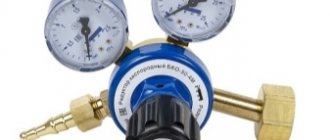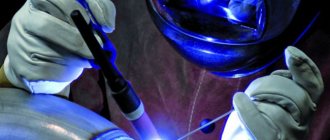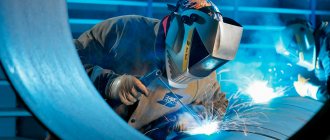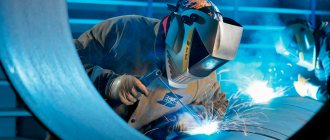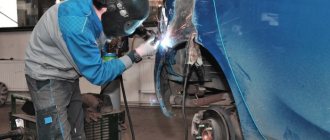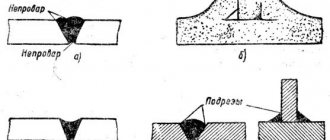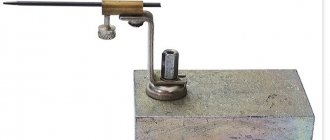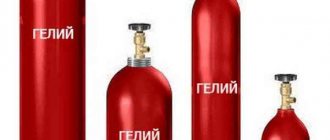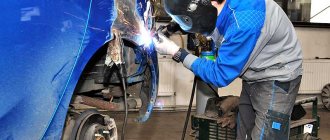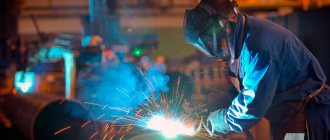Welders often underestimate the contribution of the protective environment to the welding process. Some pure gases and welding gas mixtures can affect metal transfer, alloy composition, weld shape, smoke production and many other characteristics. The correct selection of shielding gas for electric arc welding (MAG), submerged arc welding (FCAW), and tungsten arc welding (TIG) can significantly increase process intensity, quality, and deposition rates for a given weldment structure.
Varieties
Taken in the ratio established by technical standards, the components listed above can form the following mixtures of gases:
- argon plus carbon dioxide;
- argon combined with helium and oxygen (hydrogen);
- a combination of carbon dioxide and oxygen.
Some of these combinations are optimally suited for a semi-automatic machine, the design of which already provides for the possibility of their effective use. However, it will be more convenient to consider this issue after a more detailed acquaintance with the main welding mixtures.
Argon and carbon dioxide
Prepared in a certain proportion, this mixture of gases is most productive when working with carbon and low-alloy steels. When comparing the effectiveness of this combination with similar performance of welding using pure gases, it is found that this welding composition facilitates jet transfer of the electrode substance.
In addition, the seams on the finished product, in contrast to welding with pure carbon dioxide, are more even and ductile. When working with this mixture of gases, the possibility of pore formation is noticeably reduced.
Argon combined with oxygen
An argon-oxygen mixture is very often required for effective alloying of alloy and low-alloy steels. A small addition of oxygen to the working combination allows not only to eliminate the formation of pores, but also to significantly expand the capabilities of welding procedures.
First of all, this concerns changing the current control limits, as well as the use of a wider range of types of welding wire. Naturally, the quality of the weld seam formed in this case increases noticeably, as a result of which mixtures of this composition are in high demand.
Carbon dioxide and oxygen
The use of this welding gas mixture allows you to obtain the required positive effect, manifested in the following:
- the spattering of metal observed during welding is noticeably reduced;
- as a result, the quality of the formed seam improves;
- the temperature in the work area rises, which in a certain way affects the efficiency of the work being carried out (their productivity increases sharply).
However, this welding reagent has one significant drawback associated with increased oxidation of the metal in the welding zone. As a result, the mechanical parameters of the joint being formed noticeably deteriorate. In addition, this connection produces carbon monoxide, which is harmful to humans.
The influence of welding gas on the welding process
Welders and welders often overlook the shielding gas they use and its contribution to the welding process.
Shielding gases affect the metal transfer mode, the properties and geometry of the weld, smoke and many other characteristics of the weld.
The correct choice of shielding gas for metal arc welding processes such as TIG welding and semi-automatic MIG MAG welding can dramatically improve weld speed, weld quality and penetration depth.
Clean welding gases
The clean gases used for welding are argon, helium, and carbon dioxide. These gases can have both positive and negative effects on the arc welding process and the appearance of defects in the weld.
- Argon 100% argon is commonly used for TIG welding of all materials and MIG welding of non-ferrous metals. Argon is chemically inert, which makes it suitable for welding reactive and refractory metals. This gas has low thermal conductivity and ionization potential, resulting in low heat transfer to the outer region of the welding arc. As a result, a narrow arc column is formed, which in turn creates a welding seam profile traditional for welding in pure argon: deep and relatively narrow.
- Helium Helium is also a monatomic inert gas, and is most often used for TIG welding of non-ferrous metals. Unlike argon, helium has high thermal conductivity and ionization potential, which give the opposite effect than when welding in argon. Helium provides a wide weld profile, good edge wetting and higher heat input than pure argon.
- Carbon dioxide Carbon dioxide CO2, the active gas, is commonly used for semi-automatic MAG short arc welding and MAG cored wire welding. CO2 is the most common reactive gas used in MAG welding. And the only gas that can be used in its pure form without adding an inert gas. Carbon dioxide is one of the cheapest shielding gases, making it an attractive choice when material costs are a major priority in the welding process. CO2 provides very deep penetration, which is useful for welding thick metal, however, when welding in this gas, the welding arc is less stable, which leads to a lot of spatter. Also, its use is limited to short arc welding and makes jet transfer welding impossible.
Welding gases used as components of the welding gas mixture
- Oxygen Oxygen is a diatomic, active shielding gas usually used for MIG MAG welding as one of the components of the welding mixture, in a concentration of less than 10%. Oxygen provides a very wide weld profile with shallow penetration and high heat input to the metal surface. Oxygen-argon mixtures have a characteristic weld penetration profile in the form of a “nail head”. Oxygen is also used in ternary mixtures with CO2 and argon, where it provides good wettability and the benefits of jet transfer.
- Hydrogen Hydrogen is a diatomic, active component of the shielding gas, usually used in the welding mixture in a concentration of less than 10%. Hydrogen is used primarily in welding austenitic stainless steel to remove oxide and increase heat input. As with all gases made from diatomic molecules, the result is a wide weld seam on the surface. Increased penetration. Hydrogen is not suitable for ferritic or martensitic steels due to cracking. Hydrogen can be used in higher concentrations (30 to 40%) to plasma cut stainless steel to increase power and reduce slag.
- Nitrogen Nitrogen is used least often for protective purposes. It is mainly used to improve corrosion resistance in duplex steels.
Welding gas mixtures
Depending on the welding process and welding materials, many different welding gases and their mixtures are used:
| TIG welding | MIG MAG welding | |||||
| Welding gas or mixture | Steel | Stainless steel steel | Aluminum | Steel | Stainless steel steel | Aluminum |
| Argon (Ar) | X | X | X | X | ||
| Helium (He) | X | |||||
| Carbon dioxide (CO2) | X | |||||
| Ar/CO2 mixture | X | X | ||||
| Ar/O2 mixture | X | X | ||||
| Ar/He mixture | X | X | X | X | ||
| Ar/CO2/O2 mixture | X | |||||
| Ar/H2 mixture | X | |||||
| Ar/He/CO2 mixture | X | X | ||||
| He/Ar/CO2 mixture | X | |||||
The cost of welding gas against the background of the total cost of welding work
If you look at the distribution diagram of the cost of welding work, you can see that the cost of welding gas is only 2-5% of all welding costs. However, these costs should not be underestimated.
The choice of the correct gas and its quality significantly influence the consumption of welding materials, the geometry of the weld seam and the entire welding process as a whole. The choice of gas also affects the labor expended on correcting defects and processing the weld after welding.
We hope this article was useful to you. On this site you will find many other interesting and useful articles. Thank you.
© Smart Technics This article is a copyrighted product, any use and copying on the Internet is permitted with the obligatory indication of a hyperlink to the website www.smart2tech.ru
Features of argon and carbon dioxide compounds
Before deciding which gas to use in the mixture, you need to consider the features of using each of them.
According to TU 2114-001-99210100-09, all of the above compositions can be formed in a wide variety of proportions, differing in the percentage of each component. In the vast majority of these proportions, argon or oxygen is contained in volumes that make up the bulk of the substance (from 88 to 98%). The additives that complement them (carbon dioxide, in particular) rarely exceed 5-15% by volume.
Argon in proportion to helium is most often used for the processing of non-ferrous metals and their derivatives. The main types of workpieces for which argon-arc welding is used are copper, aluminum, nickel, and chromium-nickel alloys.
Welding mixtures consisting of a combination of argon and carbon dioxide are often used to heat the metal before welding or to gradually cool it after completion of work. As a rule, such a procedure is organized in cases of extreme necessity.
This gaseous composition is quite explosive, so working in a CO2 environment requires the operator to observe safety measures during its preparation and use.
The process of welding metal workpieces in mixtures with a high carbon dioxide content requires special attention. The fact is that when it combines with atmospheric oxygen, carbon monoxide is formed, dangerous to human health, to protect against which the operator must work in a special mask.
Thus, argon and carbon dioxide in combination with a number of active additives are universal welding gas mixtures used when working with most grades of ferrous and non-ferrous metals. Their combination, along with high efficiency of use, is characterized by a relatively low price.
How are welding gas mixtures supplemented?
Oxygen (O2) is a diatomic active component commonly used in gas mixtures for the electric arc welding process in concentrations below 10%. Oxygen has a heat input potential arising from both its ionization energy and its dissociation energy (the energy released by breaking a molecule into individual atoms in an arc).
The picture shows the name of the chemical element and its properties.
Oxygen creates a very wide and relatively shallow penetration profile with a high level of heat input at the surface. Because the high level of heat reduces the surface tension of the molten metal, jet transfer is facilitated, as is moisture at the weld located at the edge of the outer surface of the weld. O2/Ar mixtures exhibit a penetration profile at the nailhead level in electric arc welding of carbon steel, which is the most common application. O2 is also used in trimixes with CO2 and Ar, where it provides metal wetting and jetting benefits.
Hydrogen (H2) is a diatomic active gas that is often used in protective welding compounds in concentrations less than 10%. Hydrogen is primarily used in austenitic stainless steels to facilitate the removal of oxides or to increase heat input. As with all diatomic molecules, the result is a hotter, wider weld. Hydrogen is not suitable for working with ferritic or martensitic steels due to cracking problems. At higher concentrations (30-40%) H2 can be used to plasma cut stainless steels to increase power and reduce dross.
Nitrogen (N2) is the least commonly used additive for protective purposes. Nitrogen is mainly used to produce austenite and to improve corrosion resistance in duplex and super-duplex steels. For a more detailed introduction to this chemical element, read the article: technical nitrogen and its demand in the industrial sector.
HOW DO GASES MIX?
A rotameter can be used to carry out the mixing process. Thus, mixing occurs at the place of welding work. But this is only one mixing option, which is carried out directly at the welder’s workplace. Also, mixtures can be prepared in advance, for example, at a plant for the production of gas welding substances, and also mixed in advance, at the enterprise, before the gas arrives at the welding site. You can influence the composition of the mixture, for example, by directly regulating the flow rate of each gas in the mixture by installing the reducer on the cylinder with argon and other components to the desired level.
Application area
Welding gas mixtures are used primarily for cases where work is carried out with thin parts, non-ferrous metals and difficult-to-weld alloys. They are used in all cases where the use of a semi-automatic device is necessary. Protection from oxygen from the atmosphere is almost always required. Without the use of gases, work cannot be carried out. The only exceptions are brands of self-shielding wire, which do not require gas mixtures for welding. The main areas of use are repair shops, production of cars and other equipment, mechanical engineering, various industrial enterprises, chemical and oil industries.
Features of receiving
A mixture of gases can be obtained from two cylinders using a gas station mixer. However, the simplest models cannot ensure the stability of the mixture composition when the gas pressure in a cylinder decreases. In addition, the components in the cylinders do not run out synchronously and the welder must constantly monitor the remaining gas and frequently replace the cylinders. The behavior of carbon dioxide is especially insidious, for which it is impossible to determine the remaining gas in the cylinder and it always ends suddenly. High-quality imported station mixers with inlet flow control are very expensive (2000 Euro).
The most productive method is the factory one, where components in strictly dosed quantities are fed one by one into the cylinder through a valve. In this case, for (Ar+CO2) mixtures, the first component to be filled is carbon dioxide, which settles in the lower part of the cylinder. Argon, which is lighter than carbon dioxide and accumulates in the upper part of the cylinder, is filled next. Therefore, when filled alternately, they often turn out to be poorly mixed and do not correspond to the declared composition. In addition, the actual composition changes both with time and with changes in air temperature.
To ensure uniformity and stability, it is recommended to use a special tube on the valve inside the cylinder. In the absence of such a tube, for better mixing, it is recommended to store the cylinder in a horizontal position and rotate it from time to time (for example, roll it on the floor). It is recommended to store cylinders indoors. After a long stay in the cold and transfer of the cylinder to a warm room, the equilibrium temperature in it, equal to the ambient air temperature, is established over a long period of time (about a day).
Advantages
Each gas mixture for semi-automatic welding is unique, but in general they all have a number of advantages, which is why they deserve such widespread use in the welding field. The main advantages include:
- Gives high quality seam;
- Increases welding productivity;
- Increases work efficiency;
- Reduces the amount of splashes of molten metal from the weld pool;
- Gives stable arc burning;
- The seams become denser and at the same time more flexible;
- Increases the rate of metal melting;
- Reduces smoke levels.
Features of welding with argon mixtures
In the process, it is important to take into account some features of the mixtures used. First of all, you need to position the torch closer to the welding zone and, if possible, keep the torch closer to the vertical position. The electrode extension on the burner should be no more than 15-20 mm. When these dimensions increase, air leaks and the formation of pores in the weld are possible.
Secondly, when working, it is important to correctly set the gas flow rate in the welding torch. It is recommended that the gas flow rate in the burner (in l/min) should be set approximately equal to the burner diameter (in mm). In fact, 10-15 l.min. is usually sufficient. Physically, the gas flow can be controlled directly on the burner, for example, using a gas rotameter). When the gas flow rate in the burner decreases below 5-7 l/min and when the gas flow rate increases to more than 25-30 l/min, air leaks and the formation of pores in the weld are possible.
Thirdly, the presence of argon or oxygen increases the fluidity of the molten metal in the bath. Therefore, during operation, the gap between the workpieces should be significantly smaller than for carbon dioxide. For the same reason, difficulties may arise when connecting vertical seams. To compensate for this effect, it is necessary to reduce the mode or use compositions with a minimum argon content.
When working with welding gas mixtures, wire consumption is significantly reduced (up to 20%) and therefore excess wire often leads to the formation of a reinforced weld bead. In addition, the welding modes do not correspond to the usual modes for pure carbon dioxide. Therefore, it is necessary to correctly set the mode (arc voltage, current or welding wire feed speed) and practice new skills, including increasing speed.
When working with argon mixtures, the thermal conductivity of the gas flow in the burner decreases and the heating of the burners increases. When working in forced modes, it is necessary to use burners that are more powerful than usual.
